Pushkin Museum
| Государственный музей изобразительных искусств им. А.С. Пушкина | |
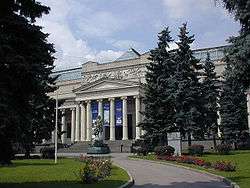 Pushkin Museum of Fine Arts. | |
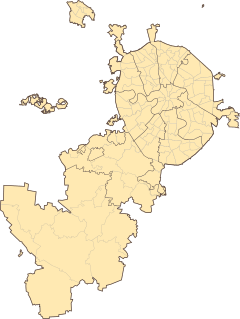 Location within Moscow | |
| Location | Moscow |
|---|---|
| Coordinates | 55°44′50″N 37°36′18″E / 55.74722°N 37.60500°E |
| Director | Marina Loshak |
| President | Irina Antonova |
| Website | Official website |
The Pushkin State Museum of Fine Arts (Russian: Музей изобразительных искусств им. А.С. Пушкина, also known as ГМИИ) is the largest museum of European art in Moscow, located in Volkhonka street, just opposite the Cathedral of Christ the Saviour. The International musical festival Svyatoslav Richter's December nights has been held in the Pushkin museum since 1981.
Etymology
The museum's current name is somewhat misleading, in that it has no direct associations with the famous Russian poet Alexander Pushkin, other than as a posthumous commemoration of his name and fame. The facility was founded by professor Ivan Tsvetaev (father of the poet Marina Tsvetaeva). Tsvetaev persuaded the millionaire and philanthropist Yuriy Nechaev-Maltsov and the fashionable architect Roman Klein of the urgent need to give Moscow a fine arts museum. After going through a number of name-changes, particularly in the transition to the Soviet-era and the return of the Russian capital to Moscow, the museum was finally renamed to honour the memory of Pushkin in 1937, the 100th anniversary of his death.
Building
The Pushkin State Museum of Fine Arts' building was designed by Roman Klein and Vladimir Shukhov and financed primarily by Yury Nechaev-Maltsov. Construction work began in 1898 and continued till 1912. Ivan Rerberg headed structural engineering effort on the museum site for 12 years, till 1909.
In 2008, President Dmitri A. Medvedev announced plans for a $177 million restoration.[1] A Rbn22 billion ($670 million) expansion, developed by Norman Foster in collaboration with local architectural firm Mosproject-5, was confirmed in 2009, but became mired in disputes with officials and preservationists and concern grew that it would not be completed on schedule for 2018. After Moscow’s chief architect Sergei Kuznetsov issued an ultimatum, demanding that Foster take a more active role in the project and prove his commitment by coming to the Russian capital within a month, Norman Foster’s firm resigned from the project in 2013.[2] In 2014, Russian architect Yuri Grigoryan, and his firm Project Meganom, were chosen to take over the project. Grigoryan’s design provides new modern buildings and, following the protest of heritage groups who campaigned to save the pre-revolutionary architecture, preserves the historic 1930s gas station near the Pushkin’s main building inside a glass structure.[3]
Collection
Fine Art Collection
%2C_oil_on_canvas%2C_82_x_101_cm%2C_Pushkin_Museum%2C_Moscow._Exhibited_at_the_1905_Salon_d'Automne.jpg)
Tsvetaev's dream was realised in May 1912, when the museum opened its doors to the public. The museum was originally named after Alexander III, although the government provided only 200,000 rubles toward its construction, in comparison with over 2 million from Nechaev-Maltsev. Its first exhibits were copies of ancient statuary, thought indispensable for the education of art students. The only genuinely ancient items - Moscow Mathematical Papyrus and Story of Wenamun - had been contributed by Vladimir Golenishchev three years earlier.
After the Russian capital was moved to Moscow in 1918, the Soviet government decided to transfer thousands of works from St Petersburg's Hermitage Museum to the new capital. The entire collection of Western art from the Museum Roumjantsev was added too. These paintings formed a nucleus of the Pushkin museum's collections of Western art. But the most important paintings were added later from the State Museum of New Western Art. These comprised Impressionist and Post-Impressionist artwork, including top works by Van Gogh, Gauguin, Picasso, Dufrénoy, Derain and Matisse. Among them, Van Gogh's "La Vigne Rouge", apparently the only painting sold during the artist's lifetime.[4] In 1937, Pushkin's name was appended to the museum, because the Soviet Union marked the centenary of the poet's death that year.
Archaeological Collection
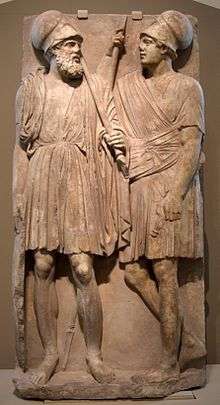
After World War II the evacuated Dresden Gallery had been stored in Moscow for 10 years. The Dresden collection was finally returned to German Democratic Republic, despite strong opposition from the museum officials, notably Irina Antonova, who had been running the museum since February 1961. The Pushkin Museum is still a main depositary of Troy's the so-called Priam's Treasure gold hoard removed from Troy by the German archaeologist, Heinrich Schliemann[5][6] and later taken by the Soviet Army (Red Army) from the Pergamon Museum in Berlin;[7] as well as other artifacts taken from Germany during the Soviet occupation at the end of the Second World War, for example the Eberswalde Hoard.
Numismatic Collection
The Pushkin Museum has a numismatic collection which is unpublished. It includes archaeological material from Central Asia, such as a hoard of Kushano-Sasanian coins acquired in 2002[8]
Gallery
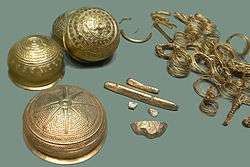
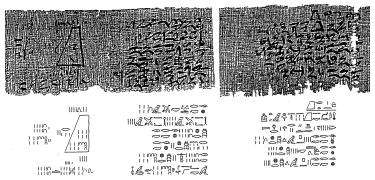

_-_Annunciation_-_Google_Art_Project.jpg) Annunciation by Sandro Botticelli
Annunciation by Sandro Botticelli.jpg) Madonna and a Child by Lucas Cranach the Elder
Madonna and a Child by Lucas Cranach the Elder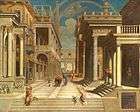 Apparition of the Sybil to the emperor Augustus by Paris Bordone
Apparition of the Sybil to the emperor Augustus by Paris Bordone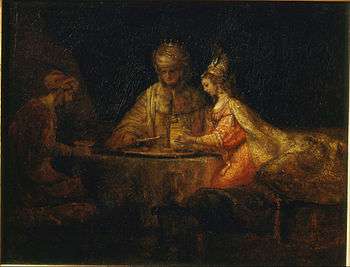
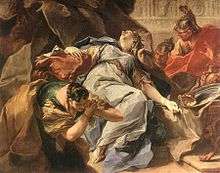 Death of Sophonisba by Giambattista Pittoni
Death of Sophonisba by Giambattista Pittoni Blue dancers by Edgar Degas
Blue dancers by Edgar Degas Fatnacht (Mardi Gras) by Paul Cézanne
Fatnacht (Mardi Gras) by Paul Cézanne
- Portrait of actress Jeane Samary by Pierre-Auguste Renoir
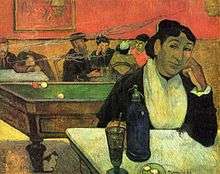 The Night Cafe, Arles by Paul Gauguin
The Night Cafe, Arles by Paul Gauguin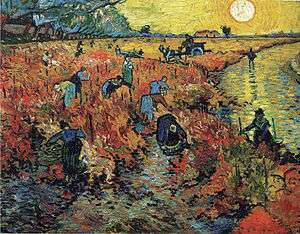 The Red Vineyard only painting sold by Vincent van Gogh
The Red Vineyard only painting sold by Vincent van Gogh%2C_oil_on_canvas%2C_147_x_95_cm%2C_The_Pushkin_Museum%2C_Moscow.jpg) Acrobat on a Ball by Pablo Picasso
Acrobat on a Ball by Pablo Picasso
References
- ↑ Lawrence Van Gelder (May 9, 2008), Pushkin Museum Overhaul Planned New York Times.
- ↑ Sophia Kishkovsky (August 16, 2013), Norman Foster resigns from Pushkin Museum expansion The Art Newspaper.
- ↑ Sophia Kishkovsky (July 2, 2014), Pushkin hires Moscow architect for expansion The Art Newspaper.
- ↑ "Anna Boch.com, the woman that bought the only painting Van Gogh sold during his life". Annaboch.com. 1986-03-03. Retrieved 2012-06-11.
- ↑ German archaeologist Heinrich Schliemann who, in 1873, illegally smuggled from Turkey to Athens the Early Bronze Age hoard of precious metalwork known as "Priam's Treasure," which he had discovered. (English) Emma Blake, Arthur Bernard Knapp (2005). The archaeology of Mediterranean prehistory. p. 307. ISBN 0-631-23268-0. Retrieved 2009-08-27.
- ↑ Schliemann illegally smuggled the loot to Berlin, convinced he had found evidence of the Iliad's famed ancient city.(English) "Top 10 Plundered Artifacts - Priam's Treasure". www.time.com. 2009-03-05. Retrieved 2009-08-27.
- ↑ Tolstikov, Vladimir; Treister, Mikhail (1996). The Gold of Troy. Searching for Homer's Fabled City. Harry N. Abrams. ISBN 0-8109-3394-2.
- ↑ Smirnova, N (1996). "Vasudeva Imitations and Kushano Sasanian Coppers from Turkmenistan". Moneti i Medali. pp. 130–133.
Further reading
- William Craft Brumfield. The Origins of Modernism in Russian Architecture (Berkeley: University of California Press, 1991) ISBN 0-520-06929-3
External links
| Wikimedia Commons has media related to Pushkin Museum. |
- The Morozov/Shchukin's collections, morozov-shchukin.com
- Pushkin Museum homepage
- Pushkin Museum History, SmashPixels.com
- Pushkin Museum of Fine Arts (Moscow)
- The Opening of the Museum, English.tsvetayeva.com
- Photo (1024x768), otdihinfo.ru
- Angela Craciun with Irina Antonova
- The State A.S.Pushkin Museum at Google Cultural Institute